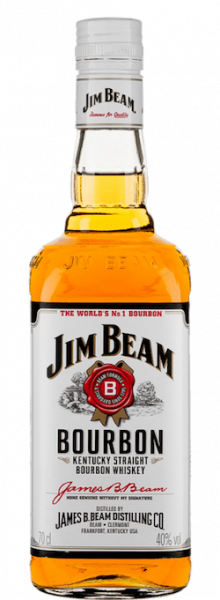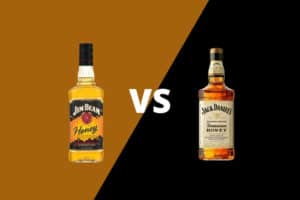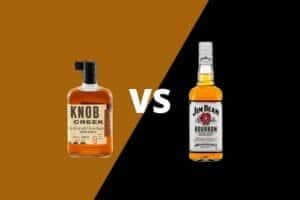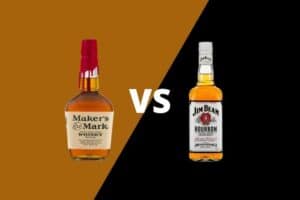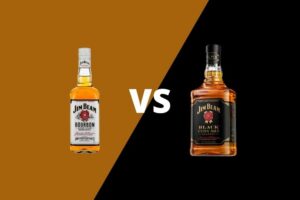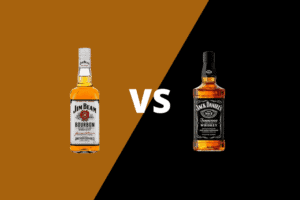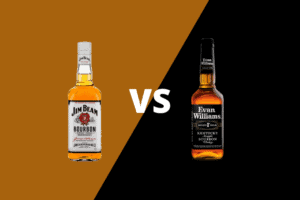Today, we’re going to take a look at Jim Beam Bourbon — the No. 1 selling bourbon, both domestically and internationally. The brand’s most widely distributed expression — known to whiskey fans as Jim Beam White Label — is recognized by whiskey fans worldwide.
In this Jim Beam White Label review, we will take a look at the brand’s history, along with its mashbill, distillation, maturation and production techniques, to learn what’s behind Jim Beam’s recognizable bourbon character. Then, we’ll peel back that label to understand what the information printed on the bottle tells us about the vibrant spirit inside.
Let’s get to it.
Grab your favorite whiskey glass, and join us as we learn more about one of the biggest names in Kentucky Straight Bourbon Whiskey — Jim Beam.
History
The history of Jim Beam, in many ways, mirrors the origins of bourbon in Kentucky.
That history began in 1778, when Jacob Beam moved to Kentucky. Soon after, around 1795, the Beam family began selling whiskey in the region. By the time Colonel James “Jim” B. Beam — the brand’s namesake — took over the family’s distilling operations in 1894, he was already a fifth-generation distiller.
In 1965, Booker Noe — Jim Beam’s grandson — took over distilling operations. Under his leadership, the distillery launched Booker’s and Knob Creek brands. These well-known bourbon brands are often credited with laying the groundwork for the whiskey renaissance that thrives to this day.
Today, the Beam family continues to be one of the most well-respected names in Kentucky, with seventh-generation distiller Fred Noe, Jr., acting as master distiller of the brand.
Mashbill
The term mashbill describes the grain ingredients used during the fermentation process.
To be labeled as a bourbon, the mashbill must contain at least 51 percent corn. The remainder consists of other grains — called secondary grains. These grains are usually a combination of malted barley, rye and wheat.
Most bourbons contain a portion of malted barley, which contains natural enzymatic properties that help convert sugars in the grain into sugars that are digestible by yeast. This process of conversion is called saccharification. While it is possible to use modern lab-produced enzymes to accomplish this reaction, most Kentucky distillers stick to the tradition of using at least a portion of malted barley, which adds a distinct character to the whiskey — sometimes described as nutty or herbal.
The remaining flavoring grain is what often differentiates types of bourbon within the category. Some whiskeys use soft and mild wheat as a flavoring grain, while many others use spicy rye grain.
Jim Beam’s mash bill of about three-quarters corn with the remainder split between malted barley and rye creates a whiskey with a traditional bourbon flavor profile.
Production Techniques
Jim Beam is owned by international spirits producer Beam Suntory. Analysts recognize Beam Suntory as the third-largest spirits producer in the world.
Jim Beam is made at the Jim Beam Distillery in Clermont, Kentucky. It is produced using modern distillation techniques, including column distillation. Barrels are aged in the traditional multi-storied wooden rickhouses that dominate most of Kentucky’s large production facilities.
A Look at the Label
Let’s check out that iconic white label. In this section, we’ll look at the whiskey label to separate the marketing copy from the genuine product attributes regulated by the U.S. Alcohol and Tobacco Tax and Trade Bureau.
The World’s No. 1 Bourbon Whiskey — Yep. This is a true statement. Although Jack Daniel’s sells more American whiskey, its designation as a Tennessee whiskey gives Jim Beam the undisputed bourbon title in volume sales.
Kentucky Straight Bourbon Whiskey — This TTB-regulated term tells us the whiskey was: 1.) distilled, matured and bottled in Kentucky, 2.) a Straight whiskey matured for no less than two years in a bonded facility, 3.) made of at least 51 percent corn and aged in new American oak barrels and 4.) made from 100 percent fermented grains.
Aged 4 Years — This is a government-regulated age statement. Every barrel used in the blending of this batch was aged for a minimum of four years. Because this age statement appears on the back label — not the front label, which is more common — Jim Beam White Label is often misidentified as a Non-Age Statement, or NAS, whiskey.
[RELATED: Jim Beam Black]
Recommended Cocktails
Jim Beam Bourbon has a suggested retail price of about $18 for a 750mL bottle. It is bottled at 80-proof. Considered a standard offering whiskey in terms of price point, its flavor profile and name recognition offers an excellent opportunity to bartenders and mixologists looking to build a profitable cocktail menu.
Hot Toddy
Ingredients
- 2 oz. Jim Beam Bourbon
- 1 oz. Honey
- 2 oz. Fresh Lemon Juice
- 1 cup Hot Water
- 1 Lemon Wheel or Twist (garnish)
Build
Heat water to a light boil using a stovetop or microwave. Add Jim Beam, Honey and Lemon Juice to a large coffee mug and top with hot water. Garnish with Lemon Wheel or Twist. Enjoy a mug to lift your spirits on a cold day.
Whiskey Smash
Ingredients
- 2 oz. Jim Beam Bourbon
- 3 Lemon Wedges
- About 6 Mint Leaves
- 1 oz. Simple Syrup
- 1 Lemon Wheel or Mint Sprig (garnish)
Build
Add lemon wedges to a two-piece cocktail shaker and muddle. Add mint leaves, simple syrup and ice. Shake until frost appears on the canister. Double strain into large rocks or old fashion glass over fresh ice. Garnish with mint sprig or lemon wheel.

